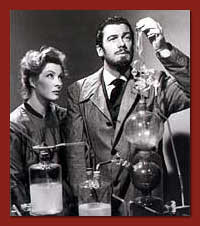|


 TENDENCY TO ROMANTICIZE HER OWN LIFE characterized Marie Curie
from girlhood on. In letters she wrote as a teenager she sometimes
presented herself as a tragic heroine. Similarly, in her 1923 biography
Pierre Curie and in the autobiographical notes appended to
it, she depicted herself and her husband as participants in a heroic
struggle. According to the self-portrait she propagated, Pierre and
Marie Curie, in their pursuit of scientific truth, had to overcome
not only poverty but also the indifference and even hostility of the
French establishment.
TENDENCY TO ROMANTICIZE HER OWN LIFE characterized Marie Curie
from girlhood on. In letters she wrote as a teenager she sometimes
presented herself as a tragic heroine. Similarly, in her 1923 biography
Pierre Curie and in the autobiographical notes appended to
it, she depicted herself and her husband as participants in a heroic
struggle. According to the self-portrait she propagated, Pierre and
Marie Curie, in their pursuit of scientific truth, had to overcome
not only poverty but also the indifference and even hostility of the
French establishment.
“My plans for the future? I have none....I mean to
get through as well as I can, and when I can do no more,
say farewell to this base world. The loss will be small,
and regret for me will be short....” --letter
of Marie Curie to her cousin Henrietta Michalowska, December
1886
|
|
 |
| The romantic--and only
partially true--legend that Curie helped create of her heroic
early struggle was further spread by the 1943 film Madame
Curie, starring Greer Garson. |
|
 |
| The facilities in the School
of Industrial Physics and Chemistry shed, a model of which is
shown here, were barely adequate, but the Curies also had the
use of lab space, raw materials, and personnel provided by industrialists.
|
|
|
While not actually
false, this image of herself and Pierre as solitary laborers in
search of knowledge is only part of the truth. For example, in her
biography Pierre Curie, Marie devotes paragraphs to describing
the miserable old shed in which she and Pierre made their significant
discoveries. What she does not tell the reader is that from early
on in their work the Curies received significant assistance from
collaborators in industry. For example, the gross treatment of the
first ton of pitchblende, donated to the Curies by the Austrian
government, was performed in the factory of the Central Chemical
Products Company, which marketed Pierre's scientific instruments.
Far from laboring entirely on their own, the Curies were allied
with the French radioelements industry that their research did so
much to develop.
As for government
research grants and salaries, Marie and Pierre were treated as well
as most good scientists of their day. The real problem, Marie and
her friends insisted, was that science as a whole got far too little
funding.
“There
was no question of obtaining the needed proper apparatus
in common use by chemists....Sometimes I had to spend a
whole day mixing a boiling mass with a heavy iron rod nearly
as large as myself. I would be broken with fatigue at the
day's end.” --Marie Curie, Autobiographical
Notes
|
The romantic image
of the struggling scientist had already been established a generation
earlier by Louis Pasteur and others. While reflecting real difficulties,
the image also served as a propaganda tool. At a time when Curie
hoped to secure funding for her Radium Institute, her emphasis on
the difficulties she faced as a scientist helped not only to arouse
public sympathy but also to raise significant philanthropic donations
and put pressure on the French government. If more money could be
won for basic research by emphasizing certain aspects of her past
and downplaying others, a larger truth would be served--scientists
everywhere could do far more for humanity if they had better funding.
“All civilized groups,” Marie wrote, “have an absolute
duty to watch over the domain of pure science...and to provide [its
workers] with the support they need.”
� 2000 -
American Institute of Physics |
|

